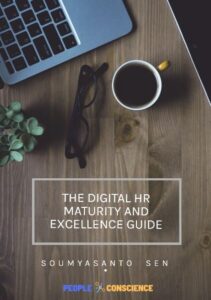Frederic Laloux in his Reinventing Organizations mentioned that through the centuries, organizations have made major contributions to humanity’s betterment, including extending life spans, eliminating deadly diseases, making education available, and developing remarkable products and services that improve life and make it more enjoyable. Now organizations dominate the way human society is structured.
The reality for most people inside most organizations today is that work doesn’t work. The way we’re organized makes it harder for us to do our work instead of easier. The way decisions are made slows things down when it should be speeding things up. And the way we collaborate and communicate with our teams makes us feel like we’d be better off working by ourselves than working together.
A Gallup global survey of employee engagement found that only 13% of employees are actually engaged at work. 63% are not engaged, and a shocking 24% are actively disengaged.
In 1958 the average lifespan of a company on the S&P 500 was over 60 years. Meaning once you made it on there; you could expect a good long run of prosperity. Today the average lifespan is just 15 years and it is keep falling.
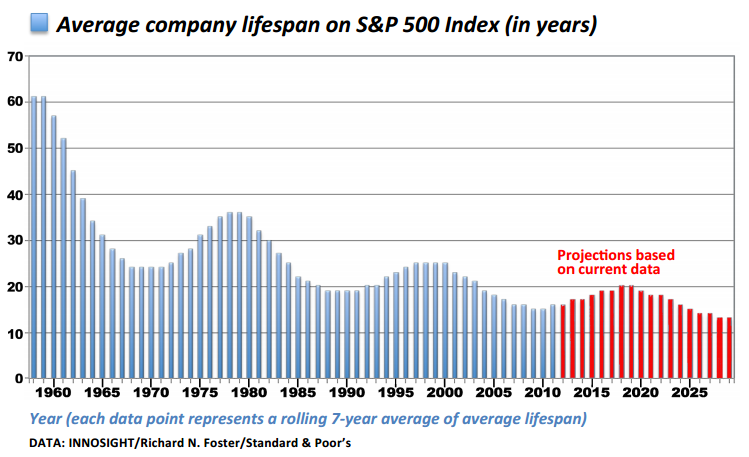
According to August, most companies just can’t squeeze any more productivity out of their firms. A recent study found that there is a small select group of “frontier” firms that have figured out how to unlock exponential productivity compared to everyone else.

We now live in a world that is defined by exponential change. This exponential change is driven — not exclusively — but more than anything else by technological innovation.
The difference between these companies that are acquiring all the benefits of this new world is that the way they work is fundamentally different.
Unlike these successful companies, most companies today are still using an obsolete operating model that was designed over 100 years ago for a world that no longer exists.
On the other hand, one could succeed by working toward a clear and specific and usually profit-driven collective purpose. And all of this worked really well in a time when it was possible and advantageous to try to predict the future. This model worked really well when it was possible and useful to try to be certain about what was going to happen next.
This difference between optimizing for certainty vs. optimizing for uncertainty is at the core of what separates successful organizations from everyone else.
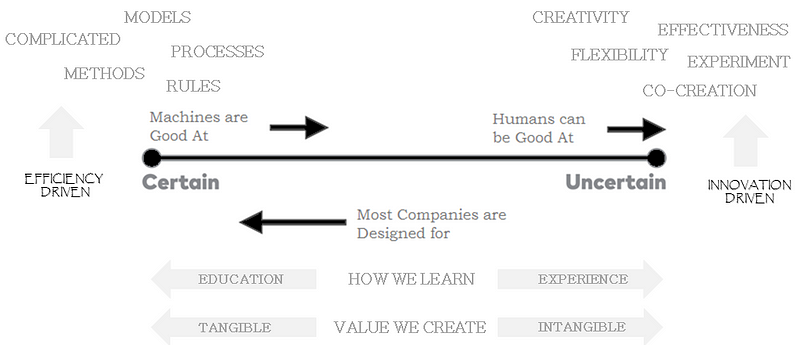
It’s no surprise then that most companies are finding it harder and harder to create any unique value at this end of the spectrum. Machines create exponential value, and very quickly those new technologies are available to everyone, preventing any one company from gaining a unique advantage.
Meanwhile, human beings are really good at the least routine, most complex, most collaborative, most creative work. And we’re much better than computers at this stuff. This is the stuff that’s really hard for computers.
And this is where teams and organizations of human beings working together toward a shared goal can create massive value.
This is where the world-changing happens. But, sadly, most organizations that we work inside of are optimized for certainty, when they should be optimized for uncertainty. Change is coming at us with the greatest velocity in human history.
Technology is accelerating the pace of business at unthinkable speeds, so much so that the job you have today is changing as quickly as you read this page. If we can barely imagine one second’s worth digital deluge, how will we get our heads around the stunningly different future of work. Because, to be clear, the team you lead and job you have today — if they exist at all — will be very different in 18 to 24 months.
Your ability to empower people to contribute no matter who they are or where they are, and to break the limits hierarchy, functional silos, cultural norms, and even the organization itself.
THE DRIFT
Work is changing. So much so, there aren’t even good words to describe where it’s headed yet.
According to LeadWise, work is becoming more centered on people instead of mechanistic systems. What does this mean? Basically, the people that work at/with a company will be more able to bring their full selves to work, instead of having to wear masks to fit into traditional corporate models.
These are People-Centric Management. These models aren’t monolithic in nature. While they share philosophical similarities, their main styles propose tools and paths to suit different organizations. The opportunity lies in adapting a more people-centric management style to your existing context. As a collaborative style of management, they often leads to a culture shift reframing value systems to include transparency, self-management, creativity as well as personal and professional growth.
By using these principles, these organizations have created systemic change in their teams, focusing on the core beliefs of people-centric management. These include enhanced employee engagement, optimized productivity through innovation and reframing control to the collective instead of a hierarchy.
Take a look at how these movements around the world are rewriting corporate narratives by putting teams first. These movements are taking us towards the next generation organizations.
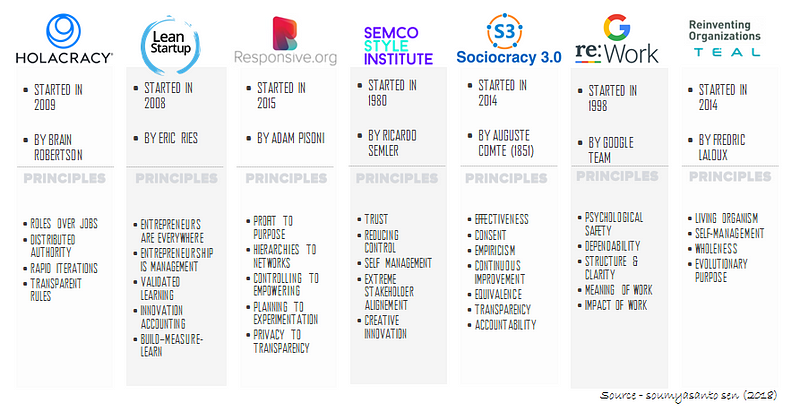
Most of them shares common traits and values and these are all related and overlapping practices, and they are all part of a much bigger and lasting shift in the way we work.
The people, who work inside these organizations, will insist that things change. And that the organizations who embrace the change will thrive. And those that either resist it or ignore it, will die. But there’s a way to change that by harnessing open learning networks to pursue a purpose beyond your bottom line.
The organizations that embrace this shift are starting a revolution that will change the lives of hundreds of millions of workers and ultimately will change the world. Rather than learning with certainty, we believe the greatest opportunity rests with those who embrace “learning uncertainty”. Learning uncertainty is the agency and agile mindset that empowers now and future generations to thrive in a rapidly shifting economy that shifts from one set of known experiences to another at break neck pace.
The most exciting breakthroughs of the twenty-first century will not occur because of technology, but because of an expanding concept of what it means to be human.
Let’s explore these movements in bit more details.
HOLOCRACY
Started in 2009 by Brian Robertson, this movement replaces the traditional management hierarchy with a “peer-to-peer” operating system that increases transparency, accountability and organizational agility. The movement’s vision is to distribute authority among its teams to empower all employees to take leadership roles and make meaningful decisions.
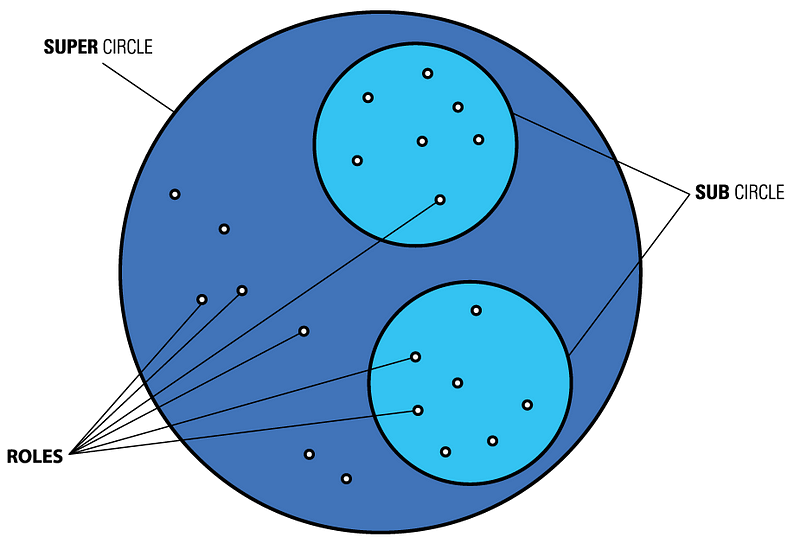
Super Circle: Contains sub-circles.| Sub-Circle: Each is dedicated to a function.| Role: A task related to a function.
Holacracy is a self-management practice for running purpose-driven, responsive companies. By empowering people to make meaningful decisions and drive change, the Holacracy practice unleashes your organization’s untapped power to pursue its purpose in the world.

For more information, visit: www.holacracy.org
LEAN STARTUP
Lean startup is a methodology for developing businesses and products, which aims to shorten product development cycles by adopting a combination of business-hypothesis-driven experimentation, iterative product releases, and validated learning. The central hypothesis of the lean startup methodology is that if startup companies invest their time into iteratively building products or services to meet the needs of early customers, they can reduce the market risks and sidestep the need for large amounts of initial project funding and expensive product launches and failures.
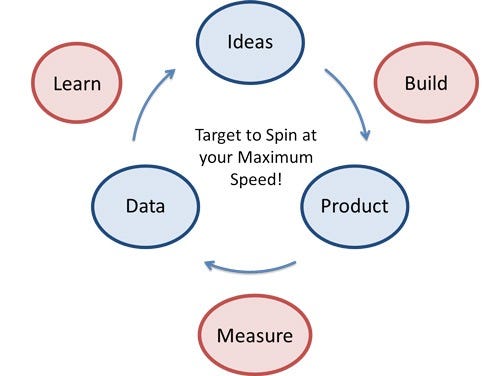
The lean startup methodology was first proposed in 2008 by Eric Ries, using his personal experiences adapting lean management principles to high-tech startup companies.The methodology has since been expanded to apply to any individual, team, or company looking to introduce new products or services into the market.
“Using the Lean Startup approach, companies can create order not chaos by providing tools to test a vision continuously.”
“The Lean Startup method teaches you how to drive a startup-how to steer, when to turn, and when to persevere-and grow a business with maximum acceleration.”
Lean Startup methodologies states:
Eliminate Uncertainity
The lack of a tailored management process has led many a start-up or, as Ries terms them, “a human institution designed to create a new product or service under conditions of extreme uncertainty”, to abandon all process. They take a “just do it” approach that avoids all forms of management. But this is not the only option. Using the Lean Startup approach, companies can create order not chaos by providing tools to test a vision continuously. Lean isn’t simply about spending less money. Lean isn’t just about failing fast, failing cheap. It is about putting a process, a methodology around the development of a product.
Work Smarter not Harder
The Lean Startup methodology has as a premise that every startup is a grand experiment that attempts to answer a question. The question is not “Can this product be built?” Instead, the questions are “Should this product be built?” and “Can we build a sustainable business around this set of products and services?” This experiment is more than just theoretical inquiry; it is a first product. If it is successful, it allows a manager to get started with his or her campaign: enlisting early adopters, adding employees to each further experiment or iteration, and eventually starting to build a product. By the time that product is ready to be distributed widely, it will already have established customers. It will have solved real problems and offer detailed specifications for what needs to be built.
Develop a MVP
A core component of Lean Startup methodology is the build-measure-learn feedback loop. The first step is figuring out the problem that needs to be solved and then developing a minimum viable product (MVP) to begin the process of learning as quickly as possible. Once the MVP is established, a startup can work on tuning the engine. This will involve measurement and learning and must include actionable metrics that can demonstrate cause and effect question.
Validated Learning
Progress in manufacturing is measured by the production of high quality goods. The unit of progress for Lean Startups is validated learning-a rigorous method for demonstrating progress when one is embedded in the soil of extreme uncertainty. Once entrepreneurs embrace validated learning, the development process can shrink substantially. When you focus on figuring the right thing to build-the thing customers want and will pay for-you need not spend months waiting for a product beta launch to change the company’s direction. Instead, entrepreneurs can adapt their plans incrementally, inch by inch, minute by minute
For more information, visit: www.theleanstartup.com
RESPONSIVE ORGANIZATION
Responsive Organizations are built to learn and respond rapidly through the open flow of information; encouraging experimentation and learning on rapid cycles; organizing as networks of employees, customers and partners, motivated by a shared purpose. This involves several paradigmatic shifts with respect to traditional organizations:
Profit ➔ Purpose: rather than viewing profit as the primary goal of an organization, it is seen a byproduct of success.
Controlling ➔ Empowering: The people with best insight and decision-making ability are often people closest to customers or at the front line. You achieve better results by inspiring and empowering people at the edges to pursue the work as they see fit.
Planning ➔ Experimentation: resources devoted to planning are a less valuable investment than embracing agile methods that encourage experimentation and fuel rapid learning, a long term vision is still needed though.
Hierarchies ➔ Networks: it is no longer necessary true that coordinating through a manager is more effective than people self-organizing as a network with increased autonomy.
Privacy ➔ Transparency: the potential benefits of trusting people who share the organization’s purpose to act on information as they see fit, often outweighs the potential risk of open information being used in counter-productive ways.
A responsive organization is only as good as what it is responding to. And in order to maximize the next generation organization it needs next generation fuel. One of the premises of the future of teams is customer obsession. But how good are we at understanding customers? Are we feeding our organizations coal and oil when their new engine runs on electricity?
Read more on What Fuels The 21st Century Responsive Organization?
According to Helge Tennø, Founder and Principal at Jokull AS, we are redesigning our organizations to fit the 21st century. We are configuring them for learning, flexibility and adaptability. To unleash the wealth that is existent in their talents and teams and reap the rewards. But in order to build a responsive organization it needs something to respond to — it needs 21st century fuel.
For more information, visit: www.responsive.org
SEMCO STYLE
Developed over 30 years ago by Ricardo Semler, this management approach organizes wisely around humans instead of smartly around structures and procedures. It is designed to treat adults as adults and put people above organizational modes.
· Promotes building a culture of trust where there is a free exchange of ideas and transparency in decisions, meetings and planning.
· Advocates for innovation and creativity to be nurtured in their employees and companies.
· Removes control systems and returns accountability and self-management to team members.
These principles go well beyond the notion of self-governance and are interdependent: eliminate one, and the others become far less meaningful. What Semco Style isn’t is a recipe you should simply follow, it is not dogmatic or unchangeable. Semco Style is the result of a lot of trial and error, of taking a few steps forward and a couple back, and it strives to remain a work in progress indefinitely.
The Semco Style Institute aims to fuel the ongoing evolvement of the Semco Style of organizing by creating a community of Certified Consultants and Semco Style Change Makers who can learn from each other.
Most people, working in conventionally managed organizations, tend to ignore the imbalances in their personal and professional lives until the moment something goes wrong. It’s a highly reactionary attitude that leads to high-strung situations, deep regrets and a drained return to the workforce. Research invariably shows that people who are unable to dedicate enough time for their personal lives tend to be employees who are physically present, yet mentally absent. And it works both ways: People who work in high stress environments often find all that negativity reflecting on their personal lives, disrupting their familial and social relationships.
For more information, visit: www.semcostyle.org
SOCIOCRACY
Conceptualized by Auguste Comté, Sociocracy can be traced back to 1851. The movement has since remerged in 2014 as Sociocracy 3.0. It enables companies and teams to manage themselves as an organic whole meaning everyone gets a voice in the management of the organization. It is designed to grow effective, agile and resilient organizations of any size, from small startups to large international and national networks.
Sociocracy shares the values of democracy
· freedom and equality, and
· the right and responsibility of self-determination.
But sociocracy doesn’t just state values. It goes deeper. It is a method of organization and decision-making that ensures those values are implemented. Its principles and practices are very different from parliamentary procedure and majority rule. Majority rule can lead to a divided society and promotes competition and dominance instead of cooperation and equality.
Sociocracy is built on seven principles that shape organizational culture. Since the seven principles are reflected in all of the patterns, understanding these principles is helpful for adopting and paramount to adapting Sociocracy 3.0 patterns. Practicing Sociocracy 3.0 helps people appreciate the essential value that these core principles bring, both to individuals and organizations.
Effectiveness: Devote time only to what brings you closer towards achieving your objectives.
Consent: Do things in the absence of reasons not to.
Empiricism: Test all assumptions through experiments, continuous revision and falsification.
Continuous Improvement: Change incrementally to accommodate steady empirical learning.
Equivalence: People affected by decisions influence and change them on the basis of reasons to do so.
Transparency: All information is available to everyone in an organization, unless there is a reason for confidentiality.
Accountability: Respond when something is needed, do what you agreed to and take ownership for the course of the organization.
There is no comprehensive list of sociocratic organizations. Most prefer to be known for their work, not how they make decisions. The now include national and international associations, building and manufacturing companies, health care services, public school systems, villages, private schools, Buddhist monasteries, software companies, residential communities, colleges, a wholesale florist company, veterinary offices, and consulting firms.
In addition to consultants working internationally to help organizations implement the method there are a growing number of websites with resources, guides to training and consultants, and social connections. A network of sociocratic organizations and individuals is being formed to increase general awareness of sociocratic principles and methods.
For more information, visit: www.sociocracy.info and www.sociocracy30.org
RE-WORK
re:Work is a collection of practices, research, and ideas from Google and others to help you put people first.
Started in 1998, re:Work is a website sharing curated guides, case studies and research about how businesses like Google and others rethink business to put people first. Their goal is to provide resources to help other organizations design workplaces to make people happier, healthier and more productive.
· Promotes managers acting as role models for continuous growth and improvement.
· Advocates for treating employees like owners.
· Removes unconscious bias replacing it with education, measurement and accountability.
re:Work is organized around ways you can make an impact in your workplace. Each subject contains tools and insights for addressing specific challenges.
· GOAL SETTING
Set goals to align efforts, communicate objectives, and measure process.
· HIRING
Make better hiring decisions through job descriptions, structured interviewing, hiring committees, and more.
· LEARNING & DEVELOPMENT
Empower your employees to grow and develop by making learning part of everyone’s job.
· MANAGERS
Identify what makes a great manager and offer feedback and development opportunities.
· PEOPLE ANALYTICS
Make informed, objective people decisions using science and data.
· TEAMS
Examine team effectiveness and how to foster psychological safety.
· UNBIASING
Reduce the influence of unconscious bias by educating, measuring, and holding everyone accountable.
For more information, visit: www.rework.withgoogle.com
TEAL
Introduced in the book Reinventing Organizations by Frederic Laloux in 2014, this movement advances the idea of soulful workplaces that focus on their impact in the world versus management targets. By focusing less on the bottom line and shareholder value and by implementing agile practices, Teal organizations are reaching new heights in financial results and are outpacing their competitors.
The next generation of organizations or teal organizations releases entrepreneurship forces and self-organization to realize a given purpose. It creates pioneer organizations with increased employee engagement, productivity and meaningfulness.
Teal organizations exhibit three distinctive characteristics:
1. Self-management– Hierarchy isn’t relevant; neither is consensus. Teal organizations manage their processes through “peer relationships.” Most of these firms provide employees with special training so they can manage their own work.
2. Wholeness — Most Teal organizations believe rationality matters above all. Anything related to the “emotional intuitive and spiritual” side isn’t as important. Teal organizations want evolved, unified employees.
3. Evolutionary purpose — Purpose matters most in Teal organizations: what they do, whom they serve and how they want to evolve.
Teal organizations use an employee-driven advice process as part of each team’s self-management. Anyone in the organization can make decisions that affect the overall company if they first consult those whom the decision will affect and those with expertise on the issue at hand.
For more information, visit: www.reinventingorganizations.com
THE NEW PARADIGM
Today, organizations face a radically shifting context for the workforce, the workplace, and the globalized world of business in general. These shifts have changed the rules for nearly every organization, the way we think about culture transformation and the pace at which we must learn to evolve the functions of leadership and management.
All business leaders have experienced these shifts. Business and HR leaders can no longer continue to operate according to old methods. They must now embrace new ways of thinking about their companies, culture, leadership, their talent, and how they approach transformation.
Organizations are focusing on group of people, a “high-performance team” who share a common vision, goals, metrics and who collaborate, challenge and hold each other accountable to achieve outstanding results. The high-performance team is regarded as tight-knit, focused on their goal and has supportive processes that will enable any team member to surmount any barriers in achieving the team’s goals.
Also if we start analyzing the important characteristics for a next generation organization mentioned previously; based on these movements we can easily visualize the most active drivers and characteristics. Most of these movements have common characteristics and their vision is to provide a better organization, a better world.
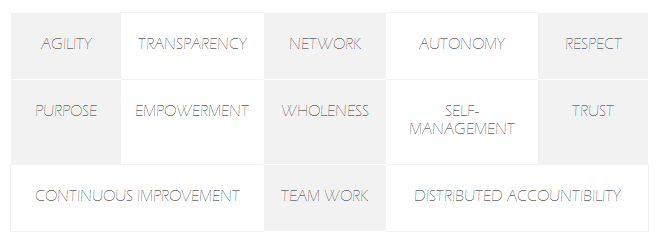
We need to change how work works. The change is not so easy but not impossible. And all these movements are meaningful when empower people to look at organizations and be able to compare them so that organizations can be valued by their real value creation.
The new economy has brought the need to tap people’s curiosity, quest for knowledge and understanding in order to develop a sustainable society. Drivers actively affecting these next generation organization movements like Trust, empowerment, transparency, respect, versatility, passion, knowledge, harmony, merit, accountability many others acts as the major change agents for transforming into a sustainable organization.
In the age of digital, the most important thing for today is to make a people-centric Sustainable Organization (SORG) for the uncertain world. And these active drivers and characteristics can play a vital role in in transforming an organization into a SORG as mentioned above.
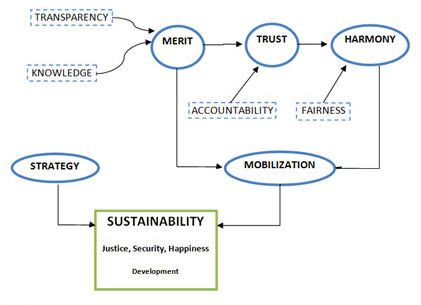
Time has come to shine the spotlight on those organizations with a sincere intention to have a positive impact on humanity and to put in the shadow the ones that tend to hide their real impact behind a “green veil”. We need a transparent, simple, speculation-free index that will bring back truth stolen by big corporations which tend to put profit above people, greed above needs and rule of gold above golden rules.
Sustainability has been a hot topic over the last three decades, although always at a very abstract and scientific level, disconnected from the concerns of the common citizen. Despite the various analyses being made by academics worldwide, most conclusions are still not considered as being part of the core of economic development. Sustainability should be considered at the genesis of any organization — business, non-profit, NGOs, government, any type or size of an organization.
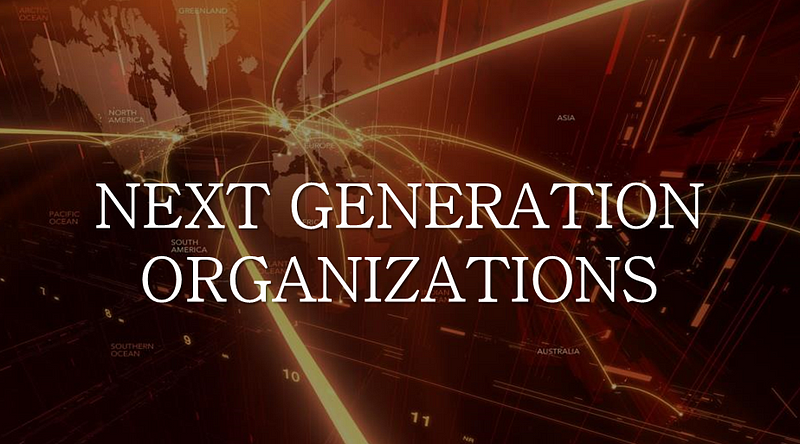
In a transparent world, a balanced distribution of the outcome produced by organizations and a stronger economic development for humanity as a whole (regardless of people’s location or activity) can lead to a better life. Similarly, enabling all members of the community to observe organizations and compare them with others, in an accountable and speculation-free system, so that they can determine the real economic value these organizations produce, creates a transparency that will necessarily enable people to build organizations characterized by a strong and positive economic development — balance and stability necessarily lead to more economic value.
We have to enlighten people to get involved in a revolution, leading to a more sustainable model and, in turn, a fairer world. For organizations to become truly sustainable — we believe it is essential to create a new organization model: a more cooperative CEO, a new way for people to cooperate inside the organization and a new way for organizations to be measured by society.
To do so, we have to put under the spotlight organizations with a sincere intention to have a positive impact on any industry and by doing so, to put in the shadow the ones that tend to hide their real impact behind a “green veil”. Those malevolent organizations tend to put profit above people, greed above needs and the rule of gold above golden rules without any concerns regarding the long-term management of their assets.
For further info, visit SUSTAINABLE ORGANISATIONS — an introduction to a new model and algorithm, introduced by the writer Miguel Reynolds Brandão
If you have more interest, please learn about all of these through the Book ‘THE SUSTAINABLE ORGANISATION’ — a paradigm for a fairer society: Think about sustainability in an age of technological progress and rising inequality.
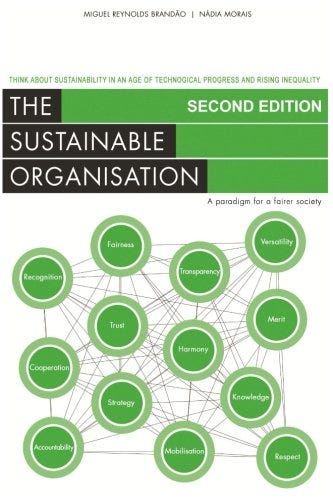
‘THE SUSTAINABLE ORGANISATION’ is also contributed by Soumyasanto Sen specially in regards to evolving next generation organizations and any feedback is highly wellcome.


